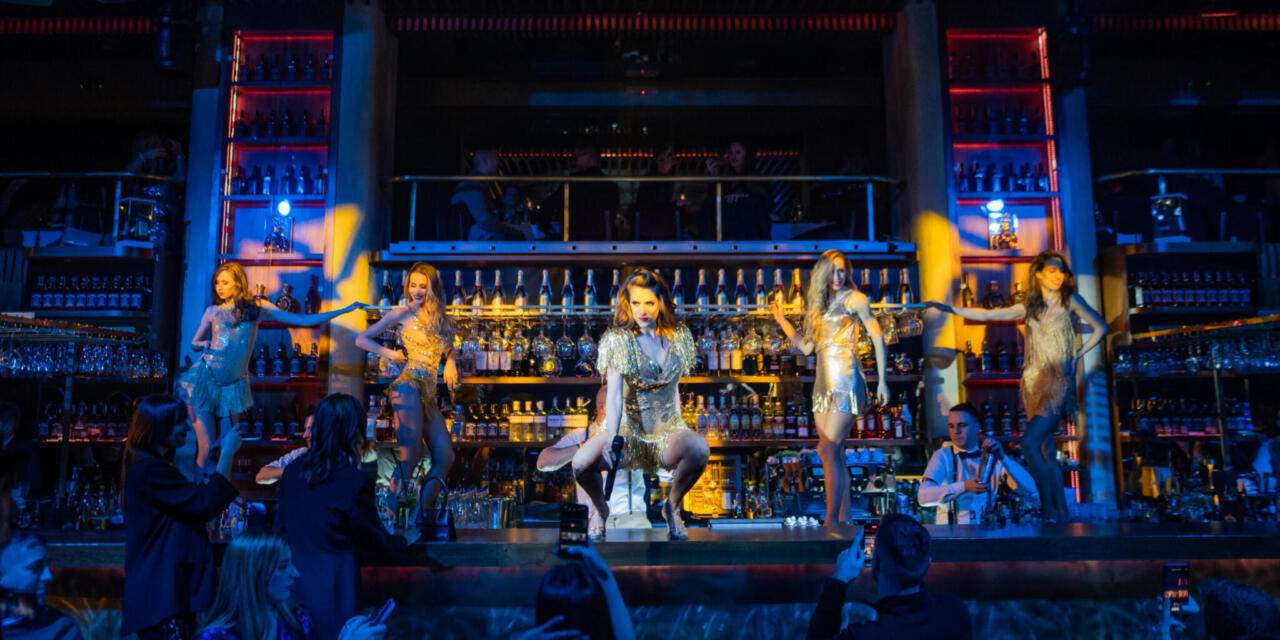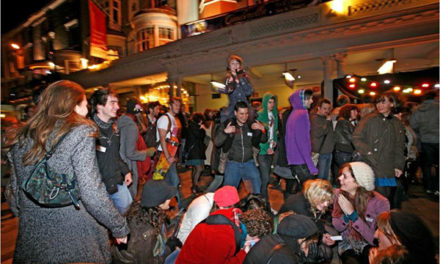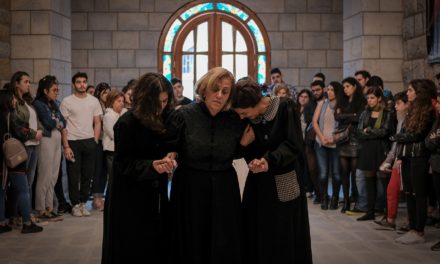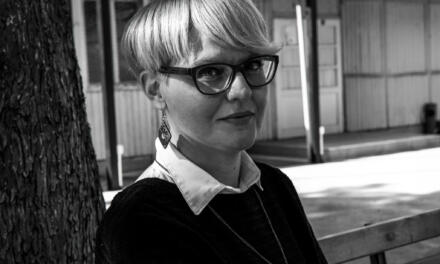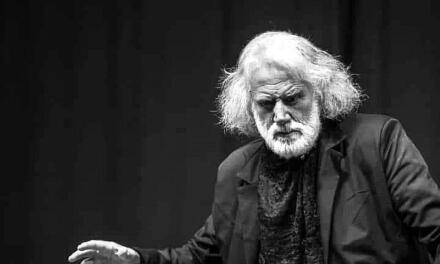Belgrade and Serbia have a three-century-long history of theatre. Along with the development of theatrical forms in Western Europe, the theater was growing in, then small, Kingdom of Serbia. However, one theatrical form never found its way to not only Belgrade but the whole of Eastern Europe and the Balkans – Cabaret. Exclusively for The Theater Times, we bring you the story of the first cabaret theater in the Serbia – Lafayette.
We had an opportunity to visit Lafayette and chat with several members of Lafayette’s team that played key roles in bringing the fantasy of cabaret to the Balkans – Aleksandar Kajmakovic (the man behind the idea and the founder of Lafayette), Milan Gromilic (creative director), Nemanja Stanojevic (theater producer), Bojana Racic (lead singer), and Ivan Zekic (actor and master of ceremonies).
Before we dive into the magnificent story of Lafayette, we will briefly introduce cabaret as a theater form and its history.
Cabaret (from the French word cabaret) is a form of entertainment theater. Cabaret’s repertoire mainly consists of chansons, sketches, satires, and short performances about politics, critique of society, or artistic direction.
Cabaret was originally conceived as an avant-garde theater for a selected audience and was later developed into a commercialized form of entertainment for a wide audience.
The program is led by a master of ceremonies and consists of simple musical pieces including singing, dancing, and other stage performances. Cabaret songs are specially written for cabaret. A lighter version of cabaret with a predominantly musical program was also called “chantan” (the French word for a cafe with a live music program).
The first cabaret was created in the 1880s Paris (Chat Noir or Black Cat, which opened in 1881). At the beginning of the 20th century, cabaret was very popular in German-speaking areas.
Just before the outbreak of the coronavirus pandemic, a group of theater enthusiasts decided to enrich the nightlife of Belgrade (also known as the European capital of entertainment) with a new prime spot in town. In December 2019, the luxury and lavish cabaret house called Lafayette opened its doors for the first time.
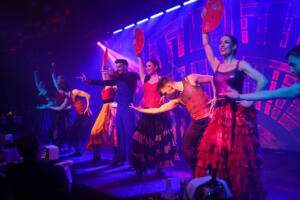
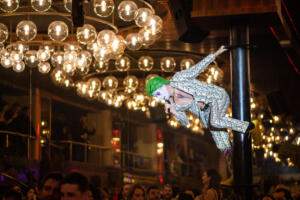
The Theatre Times: Where did the idea for starting a cabaret in Serbia come from?
Aleksandar Kajmakovic: For almost 15 years, our company has been in charge of the most popular and prestigious venues in Belgrade including not only restaurants and cafes but also nightlife and entertainment venues where the most popular Serbian and foreign musicians perform. We realized that Belgrade, one of Europe’s capitals of entertainment, is ready to take nightlife to the next level and provide a completely new, extravagant experience that immerses top-tier hospitality and best-in-line theater performance. That is how the idea for Lafayette was born.
TT: Milan, you are the creative director here at Lafayette. How big of a challenge was a task to create a show that will hold the undivided attention of the audience for the whole two hours?
Milan Gromilic: It was a big challenge; however, I believe we succeeded. We did not have any other similar venue or show to look up to for inspiration or ideas. We could have looked at the programs of the most renowned world’s cabarets – however, we knew from the start that our audience needs something different. We did not want to copy anything [show] that already exists out there – we wanted to create something new and authentic. Lafayette is indeed a unique cabaret theatre.
The first thing that catches your eye (when visiting Lafayette) is the luxurious space inspired by art deco. The auditorium is divided into three parts – an orchestra (with oval tables) and two galleries (left and right). The space is dominated by imposing chandeliers that are reminiscent of the lighting of classical theaters, there is also large mirrors that make the space look even more majestic. In addition to the standard auditorium, there are 5 VIP boxes for those who want absolute privacy. Depending on the section, the tables can seat anywhere from 4 to 20 people.
The interior of Lafayette in no way attempts to mimic the world’s most famous cabarets such as Moulin Rouge or Lido. On the contrary, it is authentic, and it skillfully plays with the previously mentioned art deco and style reminiscent of the 1960s. The stage and the bar are the two central points of the show, but we will discuss this in greater detail later.
TT: Lafayette was opened just before the outbreak of coronavirus. Did you have concerns about how the venue will survive during these trying times?
Aleksandar Kajmakovic: Coronavirus caught us all by surprise. Both hospitality and entertainment industries on which Lafayette was built were hit very hard. It was extremely difficult to see Lafayette close before it even started. Thankfully, this is all behind us. We made it to the other side stronger, and now host four shows every week.
TT: Nemanja, you are a theatre and film producer, specializing in musical theater. What is your take on Lafayette and cabaret in the 21st century?
Nemanja Stanojevic: Cabaret is a prestigious form of theatre. From the angle of a producer, it is extremely demanding. There are almost 40 performers of different backgrounds on the stage. As cabaret is so prestigious, the number of countries that have some form of cabaret is very low. It is estimated that the number of real cabaret theaters that fulfill all of the requirements (the dramatic-musical show performed in specific venues led by the master of ceremonies, with food and drinks being served to the audience) is somewhere around twenty in the whole world. With the creation of Lafayette, Serbia has joined this prestigious list of destinations that offer such a form of entertainment. Lafayette has a big role in promoting our county as well as attracting tourists from all around the world to the Serbian capital. It truly promotes both our theater scene as well as our music and ballet performers.
The show is an authentic product of Lafayette’s creative team led by creative director Milan Gromilic, one of the most famous Serbian choreographers. The show has over 40 performers and lasts almost three and a half hours (with two short intermissions). The play features artists of all profiles – actors, opera and pop singers, and classical ballet and modern dancers. An interesting twist is that the waiters and bartenders actively participate in the show by performing choreographies, directly interacting with the audience. We got an opportunity to chat with the head of the bar, Jovan Stjepanovic, and learn more about how he feels about being a part of the show along with the professional performers and artists.
Jovan Stjepanovic: The only art I was performing before joining the Lafayette team was the art of mixing drinks and cocktails. One needs to have good taste. You must have a good understanding of what the customer wants and how to serve them drinks that will simply fit their taste. I was used to getting creative, and for that reason, I did not find it difficult to follow Milan’s instructions when it comes to actively participating in the show. My piece is a very well-known “Tango de Roxanne” where I make a fire-red cocktail. The dancers are dancing around me, and the crowd is carefully following the process of mixing the drink that comes out of a flame.
The show is led by the master of ceremonies, a famous Serbian actor Ivan Zekic.
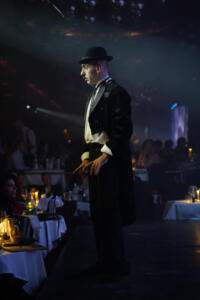
TT: What is the role of the master of ceremonies and the host in Lafayette?
Ivan Zekic: So far, I hosted over 160 shows in Lafayette. Considering that we were closed during the coronavirus pandemic, this is a very large number. I am very proud to say that I am the first master of ceremonies in the history of Serbian theatre and cabaret. The role is very difficult – Nemanja once compared the creative energy behind the master of ceremonies to the creative energy of the actor playing Goethe’s Faust. I am the one who interacts with the audience first, and, as the show is performed across the venue, for the whole three hours, I have to be very active and prepared for any unexpected situations that may occur (and prepared to improvise).
Although the play does not have a dramatic whole or a specific plot, it finds a way to cause catharsis in the audience through music and dance. Each show starts with evergreen notes of Frank Sinatra and Elvis Presley, which are followed by a block with light classical music, i.e., popular opera arias. Just like in an opera, the overture announces what comes next – superb dramatic-musical synesthesia that combines the best of the European traditional cabaret and Serbian sensibility.
The evening continues with more performances rich in dance and, what is especially important, fire. During the show, Lafayette’s team utilizes high-budget pyrotechnic devices that stimulate, excite, and transport the audience into the world of fire and magic.
Milan Gromilic: One may feel like everything is overemphasized in Lafayette – this is exactly what keeps the undivided attention of the audience, taking them on a journey through the world of cabaret for three whole hours. While creating the program, the main thing that we wanted to avoid was kitsch or distaste, which is often seen in the cabaret genre. The choice of musical pieces makes the play authentic and compensates for the lack of dramatic wholeness. In addition, it gives the play a sense of classical unities of time, place, and action. It is extremely difficult to fulfill classical drama unities with only movement and music, but I feel that we did succeed in this endeavor.
As we enjoyed the show, we did get the feeling that there is room for the pieces to be a bit more coherently connected.
Nemanja Stanojevic: In the performing sense, cabaret is an extremely demanding form – for example, the actor Nebojsa Gromilic interprets three characters and has a total of 7 costume changes. All the costume changes happen for the back-to-back performances and often Lafayette’s performers only have 15 seconds to change their costumes and jump into their next role. On the other hand, the lead singer and the crown jewel of Lafayette, Bojana Racic, performs songs of different genres (pop, ethno, rock). You can hear her soprano singing the highest and the lowest of the tones during the show.
We were very impressed by the scenography. Although there is a stage, Lafayette’s show is performed throughout the space and the artists are in immediate contact with the audience. The stage and the bar are the two central points of the show. What particularly fascinated us was the outstanding architecture and scenography. Namely, as Lafayette is located on the bank of the river Sava, the stage background can be completely opened up during the summer months – making the river and ships that sail through an integral part of the show’s scenery. During the wintertime, the stage background is closed with the LED screens on which the most modern digital scenography is projected during the show. Lafayette thus returned to the fundamental foundations of the baroque spectacle that connected nature and stage machines, an idea developed by the Italian architect Vigarani.

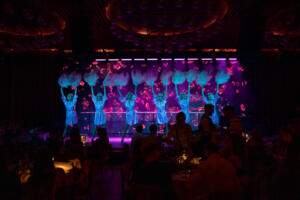
TT: (To Nemanja and Milan) Can Lafayette and cabaret as a form, in general, be categorized as “real” theater or is it a completely different type of entertainment?
Nemanja Stanojevic: Let’s go back to the times of ancient drama, when the audience sat in a round auditorium and watched the play unfold, or to the times of the baroque opera which was considered both royal and folk entertainment. During both forms of entertainment, the audience ate, drank, laughed, and walked in and out of the theaters. The three to four hours baroque operas were not meant for the audience to sit still and observe. Back then, this was considered popular music, while today we look back at it as a very sophisticated form of art. The main goal of the theater is to make the audience experience catharsis at the end of the performance. Lafayette does just that – cabaret is in fact a “par excellence” form of theatre!
Milan Gromilic: Cabaret brings all forms of theater together – dance, play, acting, comedy, love, suffering, and joy. While creating the show [Lafayette show], I used all of the available instruments in the theatre. Cabaret is the theatre – different, but nonetheless theatre. I created choreographies for countless licensed Broadway musicals here in Serbia. I invest the same creative energy into both the musicals and creating the content for the Lafayette show. Cabaret is full of theatre passion – it is a form of theatre that breaks the traditional scene and gets closer to the audience.
TT: Aleksandar, as the man behind the idea of all of this, how satisfied are you with what you have achieved so far?
Aleksandar Kajmakovic: I am satisfied – however, I believe that the job isn’t done just yet. I always aim for perfection with every venue. Lafayette is still very new. Someone would be very satisfied with the current success, but I know that we have to keep up with both the hospitality and theater aspects of Lafayette in the upcoming period. I am very grateful to my team that has made Lafayette what it is today. I strongly believe that Lafayette is proof that quality always wins and results in satisfied customers and an audience that always comes back. There is still a long road ahead of us in the years to come.
Photo credit: press photo.
This post was written by the author in their personal capacity.The opinions expressed in this article are the author’s own and do not reflect the view of The Theatre Times, their staff or collaborators.
This post was written by Nemanja Stanojevic.
The views expressed here belong to the author and do not necessarily reflect our views and opinions.

